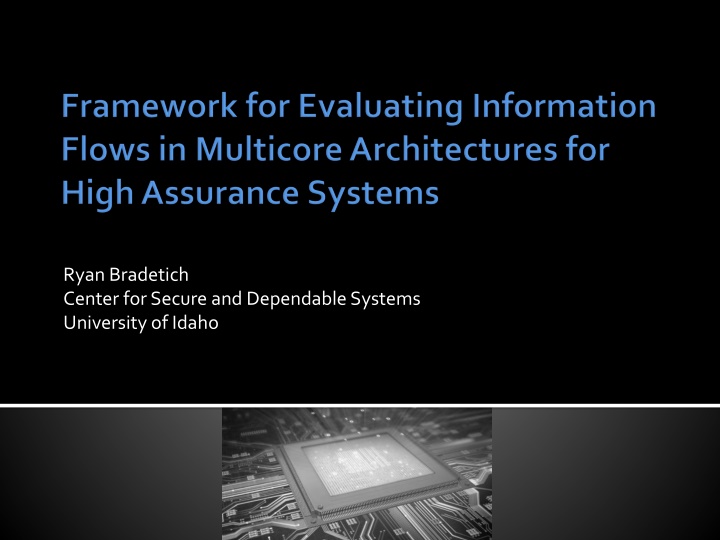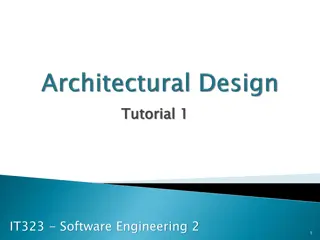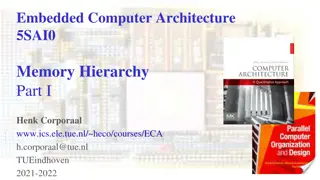Secure System Architecture Progression Framework Overview
Explore the evolution of secure system architectures, including multicore analysis and components like Cell Broadband Engine, Intel Core i, Freescale P4080. Dive into centralized processing systems, memory management, and hardware evaluations for improved processing power and security measures.
Download Presentation

Please find below an Image/Link to download the presentation.
The content on the website is provided AS IS for your information and personal use only. It may not be sold, licensed, or shared on other websites without obtaining consent from the author.If you encounter any issues during the download, it is possible that the publisher has removed the file from their server.
You are allowed to download the files provided on this website for personal or commercial use, subject to the condition that they are used lawfully. All files are the property of their respective owners.
The content on the website is provided AS IS for your information and personal use only. It may not be sold, licensed, or shared on other websites without obtaining consent from the author.
E N D
Presentation Transcript
Ryan Bradetich Center for Secure and Dependable Systems University of Idaho
Problem Statement Secure System Architecture Progression Framework Introduction MulticoreArchitecture Analysis Cell Broadband Engine Architecture (CBEA) Intel Core i (Nehalem) Freescale P4080 Question and Answers
Centralized processing System High Improved processing power MLS Commodity hardware System High Multicore architectures MILS
Memory I/O MIC SPE SPE SPE SPE IOIF0 I/O PPE SPE SPE SPE SPE IOIF1 L2 Cache Local Store L1 D L1 I SMT Core SPU Core
CPU-0 SMT CPU-1 SMT CPU-2 SMT CPU-3 SMT L1 D L1 I L1 D L1 I L1 D L1 I L1 D L1 I L2 Cache L2 Cache L2 Cache L2 Cache Shared L3 Cache DDR3 Memory Controller Quick Path Interconnect I/O Memory
Core Core Core Core L2 Cache e500mc Core Core Core Core Core SDRAM Controller Memory L3 Cache L1 D L1 I SDRAM Controller CoreNet Coherency Fabric L3 Cache I/O eLBC Controller Peripheral Controllers SEC PME RIO MU 2 x DMA QMan BMan On Chip Network Real-Time Debug 3 x PCIe 2 x sRIO FMan FMan 4 x 1GE 4 x 1GE 10GE 10GE SerDes
Framework Steps 1. Identify components 2. Analyze information flows and identify safeguards 3. Apply security policy
Red Red Networks Networks Top Secret Network Top Secret Network Black Network Secret Network Secret Network Guard Guard Confidential Network Confidential Network
Memory I/O MIC SPE SPE SPE SPE IOIF0 I/O PPE SPE SPE SPE SPE IOIF1 L2 Cache Local Store L1 D L1 I SMT Core SPU Core
Hardware Component Evaluated PowerPC Processor Element No Synergistic Processor Elements (8) Yes Element Interconnect Bus Yes Cell Broadband Engine Interface Units (2) Yes Memory Interface Controller Yes Pervasive Yes
Memory I/O MIC SPE SPE SPE SPE IOIF0 Element Interconnect Bus I/O PPE SPE SPE SPE SPE IOIF1
Not recommended for general purpose MILS multicore architecture SPE are not intended for general purpose processing. PPE must be trusted Blocking MFC communication channels provide covert communication channels.
CPU-0 SMT CPU-1 SMT CPU-2 SMT CPU-3 SMT L1 D L1 I L1 D L1 I L1 D L1 I L1 D L1 I L2 Cache L2 Cache L2 Cache L2 Cache Shared L3 Cache DDR3 Memory Controller Quick Path Interconnect I/O Memory
Hardware Component Evaluated Processor Cores (4) Partial Shared L3 Cache No Quick Path Interconnect No DDR3 Memory Controller No
CPU-0 CPU-1 CPU-2 CPU-3 Shared L3 Cache DDR3 Memory Controller Quick Path Interconnect I/O Memory
Processor Core Processor Core SMM (ring -2) SMM (ring -2) Hypervisor (ring -1) (VMX Extensions) Hypervisor (ring -1) (VMX Extensions) Guest OS (ring 0 3) Guest OS (ring 0 3)
* SIPI Attack discovered by Invisible Things Labs
CPU #0 (BSP) CPU #1 (AP) CPU #2 (AP) CPU #3 (AP) Shell Code 0xVV000 SIPI Network Interface Untrusted Driver (Malware)
Not recommended for general purpose MILS multicore architecture 35 years of backwards compatibility VMM (ring -1) added via VMX extensions VMX extensions complex and error prone VMX extensions do not address timing channels SMM (ring -2) runs higher privilege than VMM Microcode updates provide reconfigurability TXT-trusted boot does not protect against SMM SMM subject to cache poisoning via MTRR
Core Core Core Core L2 Cache e500mc Core Core Core Core Core SDRAM Controller Memory L3 Cache L1 D L1 I SDRAM Controller CoreNet Coherency Fabric L3 Cache I/O eLBC Controller Peripheral Controllers SEC PME RIO MU 2 x DMA QMan BMan On Chip Network Real-Time Debug 3 x PCIe 2 x sRIO FMan FMan 4 x 1GE 4 x 1GE 10GE 10GE SerDes
Control Plane SMP OS Data Plane AMP OS Other Services AMP OS Core Core Core Core Core Core Core Core MMU MMU MMU MMU MMU MMU MMU MMU CoreNet Coherency Fabric PAMU PAMU PAMU CoreNet Platform Caches Peripheral Peripheral Peripheral Peripheral Peripheral Peripheral
Hardware Component Evaluated e500mc Processor Cores (8) Yes CoreNet CoreNet Coherency Fabric CoreNet Platform Cache Yes DDR2/DDR3 SDRAM Controllers (2) Yes Enhanced Local Bus Controller Peripheral controllers Yes High Speed Peripheral Interface Complex PCI Express Controllers (3) RapidIO Message Unit Serial RapidIO Endpoints (2) Direct Memory Access Controllers (2) Yes
Hardware Component Evaluated Data Path Acceleration Architecture Buffer Manager Queue Manager Frame Manager (2) Pattern Match Engine Security Encryption Engine Yes Real Time Debug Yes
Core Core Core Core Core Core Core Core SDRAM Controller Memory L3 Cache SDRAM Controller CoreNet Coherency Fabric L3 Cache I/O eLBC Controller Peripheral Controllers SEC PME RIO MU 2 x DMA QMan BMan On Chip Network Real-Time Debug 3 x PCIe 2 x sRIO FMan FMan 4 x 1GE 4 x 1GE 10GE 10GE SerDes
BMan requires QMan to mediate access to CoreNet. DPAA provides direct portal access between DPAA components. Covert communication channel using the Portal Query command.
Core Core Core Core Core Core Core Memory CoreNet + SDRAM Controllers I/O eLBC Controller + Peripheral Controllers DPAA + Processor Core On Chip Network Real-Time Debug SerDes
Not recommended for general purpose MILS multicore architecture Logical Partitioning architecture looked promising. Peripherals is where the architecture fell down.
This framework shows how and why the hardware analysis can be separated from the security policy analysis. Initial component identification provides a roadmap and can foster intra-team and cross-team collaborations. Focus on information flows, safeguards, and shared components simplifies the analysis process. Consistent, reproducible, and peer- reviewable reports facilitate incremental analysis for minor hardware revisions. Safeguards organize and focus experiments on critical areas.























